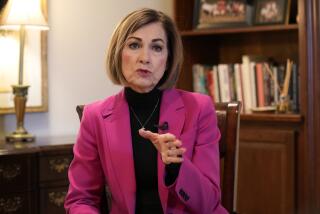Challenge to health law stokes fears

Samantha Allen always dreamed of being a photographer.
But struggling with asthma and a painful neurological disorder called fibromyalgia, she needed a job that offered health insurance. That put a freelance career out of reach.
Last year, though, Allen was able to get a health plan through the Affordable Care Act with help from a $100 monthly premium subsidy made available by the law. She quit her job at a bank and started a photography business.
“It’s made all the difference in the world,” she said recently. “I want to do this forever.”
Allen, 30, is one of millions of Americans who have come to rely on the insurance aid in the law. Few of them will be in the courtroom Wednesday when the Supreme Court takes up a legal challenge to the subsidies, but perhaps no one has more at stake. An estimated 7 million people could lose assistance if the court backs the challengers.
The lawsuit — spearheaded by conservative and libertarian activists — argues that a strict reading of the statute makes subsidies available only in the handful of states like California that established their own insurance marketplaces through the law.
Thirty-seven states, including New Hampshire, elected instead to have the federal government fully or partially operate their marketplaces using the HealthCare.gov website.
The marketplaces, a central pillar of the law, allow Americans who don’t get health benefits at work to shop online among plans that must all offer basic benefits and cannot turn away customers, even if they’re sick.
Consumers making less than four times the federal poverty level — about $47,000 for a single person or $97,000 for a family of four — qualify for subsidies to offset the cost of their premiums.
------------
FOR THE RECORD
8:17 a.m., March 3: An earlier version of this article gave incorrect consumer income levels that trigger subsidies under the Affordable Care Act. ACA subsidies are available to people making up to four times the federal poverty level, or about $47,000 for a single person, not $24,000, and $97,000 for a family of four, not $94,000.
------------
The monthly assistance, which average $268 per person, has been essential, said Jodi Ray, project director for Florida Covering Kids & Families. The nonprofit coordinated sign-up efforts across Florida, which had the largest enrollment of any state relying on HealthCare.gov.
“It has been the difference between people being able to get insurance or not,” she said.
Nearly 9 in 10 people who signed up for health coverage this year qualified for assistance, according to the U.S. Department of Health and Human Services.
Many probably couldn’t get insurance previously, either because they had preexisting medical conditions or couldn’t afford a plan. More than half of 2014 enrollees were previously uninsured, independent surveys indicate.
Allen, who lives with her dog Moxie and cat Monster in a first-floor apartment not far from the old textile mills on the Merrimack River that once dominated Manchester, was among another group of people the health law was designed to help.
They were people stuck in “job lock,” unable to pursue new careers because they needed the health benefits offered by their current employers.
Allen got an administrative job at a local bank after her parents moved their antique shop, where she used to work, to another part of the state.
On weekends, she tried to pursue photography, which she had studied in college, but progress was difficult. “I didn’t have a lot of free time,” she said.
With the insurance marketplaces scheduled to begin offering coverage in 2014, Allen took a chance and left the bank. “It was never a good fit for me.”
Last April, she signed up for a plan with a $205 monthly premium and an $1,150 deductible. With a $100 subsidy, she ended up paying just $105 every month.
“It was an awesome deal,” she said.
More important, the insurance allowed Allen to devote herself fully to photography.
Getting the freelance business off the ground, a common career path for photographers, hasn’t been easy. Though she shot 25 weddings last year, finding work in winters is tougher. But Allen is undeterred.
She loves taking photographs at weddings. “It feels like such a privilege,” she said. And she is working with two local studios.
“It’s hard to even put into words what this has meant to me. I am just a much happier person.”
That, in turn, has had health benefits, Allen said. Her fibromyalgia, which research suggests can be stress-related, flares less frequently. And she no longer needs asthma pills.
Motivated after her mother’s recent death from cancer, she is now working to connect volunteer photographers to families dealing with the illness to shoot portraits for free.
Until a few weeks ago, Allen didn’t know that she might lose the subsidies. “It’s kind of scary,” she said, adding that she tries not to think about it.
Without a subsidy, she said, she would probably have to drop her health plan. Premiums for everyone are expected to rise dramatically if the subsidies are stricken, in large part because only the sickest customers would probably remain in the market, pushing up costs for insurers.
If Allen stopped working, she might qualify for fully subsidized government Medicaid coverage. But she said she wants to work.
In Washington, Sam Katzman, general counsel for the Competitive Enterprise Institute, which has funded the legal challenge, brushed off the disruptions to people’s lives the lawsuit could cause.
He noted that other Americans have been harmed by the health law, including consumers who lost their old health plans and taxpayers who are funding the subsidies.
“As to those who fear losing access to medical treatment, we hope they do not, and we believe they will not because state and federal governments have the opportunity to create alternatives.
“But to the extent that problems do occur, remember that the culprit here is the IRS,” he said, referring to the federal tax agency’s regulations that make the subsidies available in all states.
The IRS regulations are overwhelmingly supported by the legislation’s authors and many legal experts.
For her part, Allen said she is baffled by the push to scrap the insurance assistance. She plans to come to Washington this week to support consumer advocates such as Families USA that are protesting the legal challenge.
“I don’t see who benefits from this,” she said. “Isn’t my experience supposed to be what is possible in this country — starting a business, maybe becoming a job creator?”







